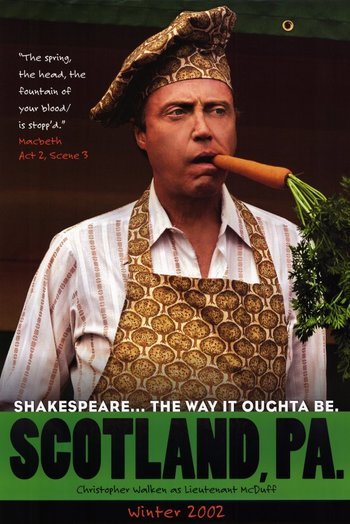Here’s the brief end of the section on Scotland, PA before we move onto the last text. As mentioned last entry, Scotland,
PA, in addition to a linguistic shift, has also undergone a shift in medium – from theatrical text to film – and it’s one on which Morrissette capitalizes. Film and theatre are relatively similar modes utilizing similar sign systems. Film technology does, however, generally allow for greater naturalism.[1] What’s more, film permits narrative tools like scene cuts between multiple locations on top of the visual and aural signs already available in a theatrical performance (i.e. costume and set design or music and sound effects). Morrissette takes advantage of this in Scotland, PA’s climax, presenting Pat and Mac’s deaths as interspersed, parallel narratives. The film cuts between Mac’s confrontation with McDuff at the restaurant and Pat’s breakdown at home. We see how Mac lures McDuff to the roof, where he ambushes him, brandishing a gun. Their dialogue alternates with scenes of Pat’s perusal of her knives before selecting the cleaver with which she will rid herself of her hand. By switching back and forth between the two scenes, Morrissette creates suspense leading up to the couple’s deaths and narratively links their opposing mental declines; Mac continues to commit violence against those around him, but Pat’s guilt causes her to harm only herself. This also offers Pat a more conclusive ending than Lady Macbeth’s. Pat McBeth is clearly the mastermind in Scotland, PA, goading her slacker husband to aim higher than his station. The visual inclusion of this ultimate consequence of her guilt allows Morrissette to highlight her agency and importance as a character who deserves an ending every bit as poetically justified as that of her husband.
Despite the film medium’s advantages – like its ability to intersperse parallel scenes – it also has some limitations compared to early modern plays in particular, mainly due to the convention of soliloquies, which Shakespeare frequently uses to invite his audience into a character’s inner thoughts. Hutcheon notes that such interiority is often easier to convey in the telling mode (i.e., a novel) than in the showing mode and that, “the performing arts, with their direct visual and aural perception… are more suited to representing exteriority.”[2] While adaptation from stage to film remains within the showing mode, I’d argue that Shakespeare’s soliloquies present some of the same challenges faced by a film adaptation of a novel. While it’s expected within the conventions of early modern performance to have characters directly address their audience, this often seems odd in the more naturalistic film medium. So rather than including a clumsy fourth wall break or voice-over Morrissette relies on the actors’ faces and gestures to reveal their inner emotional turmoil. Hutcheon admits that knowing audiences could have an advantage in these instances: “we inevitably fill in any gaps in the adaptation with information from the adapted text.”[3]
A knowing spectator may recognize echoes of Macbeth’s laments, “Better be with the dead,/ Whom we, to gain our peace, have sent to peace,/ Than on the torture of the mind to lie/ In restless ecstasy” (III.ii.20-4) and Lady Macbeth’s “’Tis safer to be that which we destroy/ than by destruction dwell in doubtful joy” (III.ii.7-8) in the couple’s empty stares as they await their restaurant’s grand re-opening party (the banquet at which Banquo’s ghost will appear). Ominous music helps to set a dour tone for their reveries, and their lack of satisfaction is effectively conveyed. Once again, however, Morrissette shifts from the drama of this image to comedy when an employee pops his head in to tell them that the crowd awaits. His appearance startles Pat who swears loudly and upsets the dramatic tension established by the preceding shot.
I have said before that Morrissette uses the film’s quick shifts between genuine drama and irreverent comedy to highlight the palimpsestic doubleness of his film and the tension between the competing genres of source and adaptation. I think that this is what allows the film to succeed as an adaptation; rather than diluting either the timeless themes or the comic environment, each is made stronger by the contrast. Some reviewers disagree, however. Ed Gonzalez argues that, “Morrissette is considerably more deft at rendering humor than he is at updating the story’s more dramatic elements”[4] and ultimately decides that “Scotland, PA is entirely too straight-faced to transcend its clever concept… It’s just not as funny as it deserves to be.”[5] I counter that Gonzalez is mistaken in the assumption that Scotland, PA deserves to be funny. By all rights, it should be a tragedy; it is funny not because it deserves to be, but rather in spite of its source material and plot. And the humor does not come from the sight-gags or “period trappings” that Gonzalez accuses Morrissette of piling on,[6] but rather how these elements offer a backdrop for the sincerity with which the actors approach their roles. Despite the small-town setting, the monumental themes of Shakespeare’s tale of treason, regicide, and monarchy are fully respected and fully realized. Still the film avoids taking itself too seriously, instead allowing the humor that arises from these themes in this setting to bubble to the surface throughout the film. The tension between original and source; tragedy and comedy; Scotland, UK and Scotland, PA allows the film to function, as Owen Gleiberman puts it, as “a joke at once flaky and resonant, lightweight and bizarrely original.”[7]
Unknowing audiences, however, will likely have a very different viewing experience, and I do admit that Morrissette’s film is much more reliant on this type of audience than Felipe’s Macbeth o el asesino del sueño. Still, Ebert offers conflicting opinions on the ideal audience, claiming that, “If you know Macbeth, it’s funny. Anyone who doesn’t is going to think these people are acting mighty peculiar.”[8] He later writes, however: “I have the curious suspicion that it will be enjoyed most by someone who knows absolutely nothing about Shakespeare, and can see it simply as the story of some very strange people who seem to reading from the same secret script.”[9] That secret script is, of course, the original play, but even the recognition that a secret script exists suggests that the audience will be viewing the adaptation as an adaptation, if not exactly as a knowing audience. Gonzalez casts doubt on this: “Morrissette’s script is so uniquely idiosyncratic you wouldn’t even recognize the Bard’s influence if it weren’t for character names and the ‘story by William Shakespeare’ credit.”[10] Despite this, Gonzalez also glibly remarks, “You know the drill: revenge, murder, and fate take their toll on a scrupulous man and wife.”[11] But which is it? If the audience is given very little to tie the film to its source text, do we know the drill? Or, as Ebert suggests, are these people going to seem “mighty peculiar”?[12] Will that improve or impoverish the viewing experience? To my mind, the film’s exaggerated tension between source and target is a key element of its humor, and I therefore question the film’s ability to act as a standalone. That said, Macbeth is a famous enough source that, especially when translated within the English language, audiences are likely to at least partially recognize its origins, and perhaps a quick look at a plot synopsis will be enough for them to appreciate the film in all its palimpsestic doubleness. It fascinates me, too, that this is a question I truly can’t answer because I have read and watched – and acted in – so many versions of Macbeth at this point (shocking when I wrote my thesis on it), that I can’t possibly approach this film as an unknowing audience. Short of sending a survey out to all my friends who maybe read Hamlet once in high school – “the ‘to be or not to be’ one, right?” – and asking what they think, I’ll have to be content to say that I really like this movie, and my enjoyment has only been enhanced by my knowledge of the source. Next week we’ll see how being a knowing audience affects my final text, Punch Drunk’s Sleep No More. Read it here.
[1] Hutcheon, A Theory of Adaptation, 35.
[2] Ibid.
[3] Ibid., 121.
[4] Ed Gonzalez, “Review: Scotland, PA,” Slant Magazine, February 4, 2002.
[5] Ibid.
[6] Ibid.
[7] Owen Gleiberman, “Scotland, PA,” Entertainment Weekly, March 17, 2020.
[8] Ebert, “Scotland, Pa.”
[9] Ibid.
[10] Gonzalez, “Review: Scotland, PA.”
[11] Ibid.
[12] Ebert, “Scotland, Pa.”

